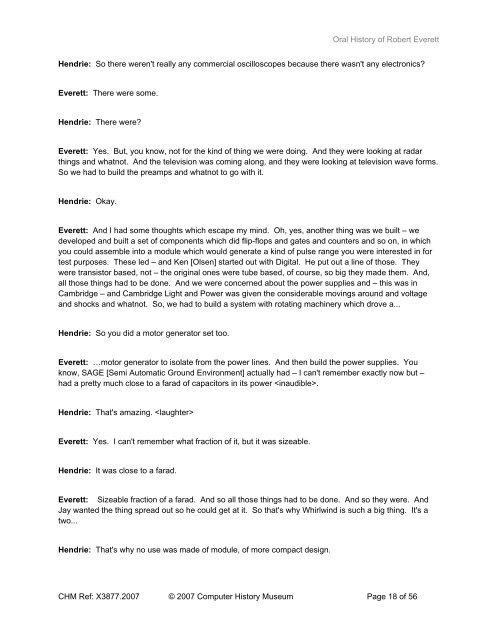Oral History of Robert Everett - Computer History Museum
Oral History of Robert Everett - Computer History Museum
Oral History of Robert Everett - Computer History Museum
You also want an ePaper? Increase the reach of your titles
YUMPU automatically turns print PDFs into web optimized ePapers that Google loves.
<strong>Oral</strong> <strong>History</strong> <strong>of</strong> <strong>Robert</strong> <strong>Everett</strong><br />
Hendrie: So there weren't really any commercial oscilloscopes because there wasn't any electronics?<br />
<strong>Everett</strong>: There were some.<br />
Hendrie: There were?<br />
<strong>Everett</strong>: Yes. But, you know, not for the kind <strong>of</strong> thing we were doing. And they were looking at radar<br />
things and whatnot. And the television was coming along, and they were looking at television wave forms.<br />
So we had to build the preamps and whatnot to go with it.<br />
Hendrie: Okay.<br />
<strong>Everett</strong>: And I had some thoughts which escape my mind. Oh, yes, another thing was we built – we<br />
developed and built a set <strong>of</strong> components which did flip-flops and gates and counters and so on, in which<br />
you could assemble into a module which would generate a kind <strong>of</strong> pulse range you were interested in for<br />
test purposes. These led – and Ken [Olsen] started out with Digital. He put out a line <strong>of</strong> those. They<br />
were transistor based, not – the original ones were tube based, <strong>of</strong> course, so big they made them. And,<br />
all those things had to be done. And we were concerned about the power supplies and – this was in<br />
Cambridge – and Cambridge Light and Power was given the considerable movings around and voltage<br />
and shocks and whatnot. So, we had to build a system with rotating machinery which drove a...<br />
Hendrie: So you did a motor generator set too.<br />
<strong>Everett</strong>: …motor generator to isolate from the power lines. And then build the power supplies. You<br />
know, SAGE [Semi Automatic Ground Environment] actually had – I can't remember exactly now but –<br />
had a pretty much close to a farad <strong>of</strong> capacitors in its power .<br />
Hendrie: That's amazing. <br />
<strong>Everett</strong>: Yes. I can't remember what fraction <strong>of</strong> it, but it was sizeable.<br />
Hendrie: It was close to a farad.<br />
<strong>Everett</strong>: Sizeable fraction <strong>of</strong> a farad. And so all those things had to be done. And so they were. And<br />
Jay wanted the thing spread out so he could get at it. So that's why Whirlwind is such a big thing. It's a<br />
two...<br />
Hendrie: That's why no use was made <strong>of</strong> module, <strong>of</strong> more compact design.<br />
CHM Ref: X3877.2007 © 2007 <strong>Computer</strong> <strong>History</strong> <strong>Museum</strong> Page 18 <strong>of</strong> 56















